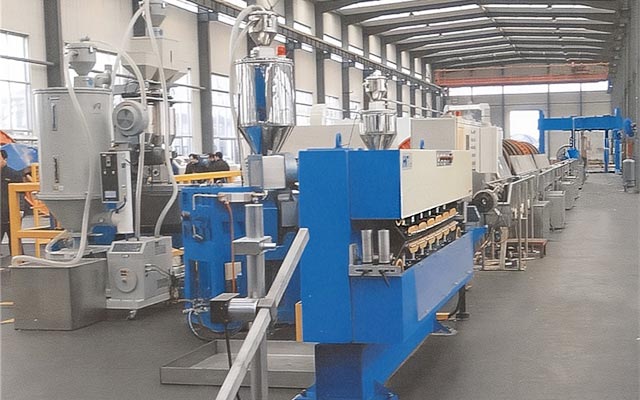Model 70-120Screw Diameter φ70-120L/D Ratio 26:1/25:1Extrusion Output 140-450 kg/hMain Motor 40-165 KWOutlet Diameter 2-80 mmSpeed 80-300Application NA2XY power cable
NA2XY Power Cable Extrusion Line
NA2XY is a type of power cable that complies with the German VDE standard (DIN VDE 0276). Its full name is Aluminum Core XLPE Insulated PVC Sheathed Power Cable. It is a power cable with distinct European (particularly German) characteristics.
Letter Meaning Analysis:N: Complies with German standards (Norm).
A: Conductor material is aluminum. If it were a copper conductor, it would be marked as "K" or omitted.
2X: Insulation material is cross-linked polyethylene (XLPE Insulation). This is key to its performance.
Y: Sheath material is polyvinyl chloride (PVC Sheath).
Full Name: Aluminum Core XLPE Insulated PVC Sheathed Power Cable.
Execution Standard: DIN VDE 0276 series standards (German Association of Electrical Engineers standards).
Rated Voltage: Commonly 0.6/1 kV.
Operating Temperature:Long-term allowable operating temperature: ≤ 90°C (thanks to XLPE insulation).
Short-circuit temperature (max. 5s duration): ≤ 250°C.
Main Features:Advantages:
Excellent Electrical Performance: XLPE insulation provides high insulation resistance, low dielectric loss, and outstanding heat resistance.
High Current-Carrying Capacity: The long-term operating temperature of 90°C means that, for the same cross-section, its current-carrying capacity is higher than that of PVC-insulated (70°C) cables.
Lightweight and Cost-Effective: The use of aluminum conductors makes it lighter than copper conductor cables and reduces initial procurement costs.
Mechanical Protection: The PVC sheath provides certain corrosion resistance, moisture resistance, and mechanical protection.
Disadvantages:
Contains Halogens: The PVC sheath produces large amounts of black smoke and toxic, corrosive halogen acid gases when burned, which is detrimental to personnel evacuation and equipment safety.
Limitations of Aluminum Conductors: Aluminum has lower mechanical strength and higher connection process requirements compared to copper, with risks of oxidation and creep. Special terminals must be used.
NA2XY Power Cable Extrusion Line
The NA2XY low-voltage power cable extrusion production line is a complete set of equipment specifically designed for manufacturing insulated cores and protective sheaths of power cables rated at 0.6/1 kV and below. Its core process involves melting solid plastics (such as PVC or XLPE) through heating and pressurization, then continuously and uniformly coating conductors (copper/aluminum wires) or assembled cable cores. After cooling and solidification, a smooth, dense, and uniformly thick insulating layer or protective sheath is formed.
Core Components
The NA2XY power cable extrusion production line is a highly coordinated automated system, primarily consisting of the following major components:
Pay-off Unit:Supports and releases the conductor or cable core, providing stable and controllable tension to prevent thinning or twisting of the conductor.
Preheater:Heats the conductor before it enters the die head to remove moisture, reduce internal stress, and improve adhesion between the plastic and the conductor.
Extruder:Screw: Conveys, compacts, melts, and homogenizes the plastic.
Barrel: Heats and cools the plastic.
Drive Motor: Provides power to the screw.
Die Head: Connects the extruder to the die.
Die (Tip and Die): Determines the thickness, concentricity, and shape of the extruded layer.
Cooling Trough:Rapidly cools and solidifies the high-temperature cable. Typically features segmented temperature control to ensure material stability and avoid internal stress.
Haul-off Unit:Provides the driving force for the production line. Its speed must be extremely stable, as it is critical for ensuring uniform extrusion thickness.
Spark Tester:An online quality inspection device that applies high voltage to the insulating layer to detect defects such as pinholes or impurities, triggering alarms and marking the locations.
Take-up Unit:Winds the finished cable neatly onto a reel, maintaining constant tension and synchronizing with the haul-off speed.
Control System:Uses a PLC / industrial computer to centrally control all parameters (temperature, speed, tension, etc.), ensuring stable and reproducible production.
NA2XY Power Cable Extrusion Line Datasheet
| Model |
70 |
80 |
90 |
100 |
120 |
| Screw Diameter (mm) |
φ70 |
φ80 |
φ90 |
φ100 |
φ120 |
| Screw L/D Ratio |
26:1 |
26:1 |
26:1 |
25:1 |
25:1 |
| Extrusion Amount (kg/hr) |
140 |
200 |
250 |
320 |
450 |
| Outlet Wire (mm) |
2-15 |
3-25 |
5-35 |
8-60 |
10-80 |
| Total Power (KW) |
40 |
55 |
63 |
120 |
165 |
| Production Speed(Max., m/min) |
300 |
200 |
200 |
100 |
80 |
| Take-up Spool |
500/800 |
800/1250 |
800/1600 |
1000/2000 |
2000/2500 |
| Storage Length |
240 m |
200 m |
180 m |
0 |
0 |
NA2XY Power Cable Extrusion Line Application
The NA2XY low-voltage power cable extrusion production line is a complete set of equipment specifically designed for producing NA2XY cables & other insulation cores and sheaths of power cables with rated voltage of 0.6/1kV and below. The details are as follows:
Conductor Insulation
Function: Extrudes insulating material onto copper or aluminum conductors to form the primary insulation layer.
Common Materials: Cross-linked polyethylene (XLPE), polyethylene (PE), polyvinyl chloride (PVC), etc.
Requirements: Uniform thickness, high concentricity, absence of impurities, and no microvoids. The insulation extrusion process for high-voltage cables demands the highest technical precision.
Sheathing Extrusion
Function: Extrudes a protective sheath over the assembled cable core.
Purpose: Provides mechanical protection, corrosion resistance, moisture resistance, UV resistance, flame retardancy, etc.
Common Materials: Polyvinyl chloride (PVC), polyethylene (PE), polyolefins, etc.


